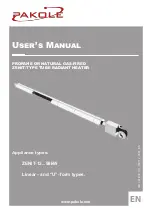
8/25
3.3.1 Flues for power vented installations
(Type B appliances)
If the air heater is to be installed as a type B
appliance, air for combustion will be taken from
within the space where the heater is installed.
Ensure that an adequate air supply for combustion
and ventilation is provided within the building in
accordance with the regulations & rules in force.
Table 5 shows flue pipe sizes and maximum pipe
lengths. The minimum flue length is 0.5 metres.
Table 5 Flue pipe diameters & maximum lengths
12
35->145
Heater socket &
pipe dia
Equivalent length
m
of 45° elbow
1.5
80
9
20, 30
100
130
LCSA-4
mm
m
Equivalent length
of 90° elbow
Maximum straight
length
m
0.75
Single wall flue pipes are required. All joints must
be sealed to prevent products of combustion from
leaking into the building. An approved flue terminal
is required.
If the flue passes through a combustible element of
the building it must be enclosed by a sleeve of non-
combustible material and separated from the sleeve
by at least a 25 mm air break. The temperature of
any combustible material near to the flue must not
exceed 65°C when the heater is in operation. The
flue must be at least 50 mm away from any
combustible material.
Single wall flue pipe exposed to cold air or run
through unheated areas must be insulated. Where
condensation is unavoidable, provision must be
made for the condensation to flow freely to a point
to which it can be released, i.e. a drain or gully. The
condensation drain from the flue must be
constructed from non-corrodible material not less
than 20 mm diameter. Copper or copper based
alloys must not be used for condensation drains.
3.3.2 Combustion air inlet pipe & flue pipe for
balanced flue installation (Type C appliances)
Balanced flue air heaters are designed to be fitted
with a combustion air inlet pipe that obtains outdoor
air and a flue pipe that exhausts flue products to
outdoors.
Air heaters if fitted with a power venter permitting
either a vertical or horizontal combustion air
inlet/flue pipe system.
The heaters must be
installed with a concentric vertical or horizontal
flue/combustion air inlet. The heaters are only
approved for use when installed with the
appropriate approved concentric vent terminal.
See table 6.
Both the flue and combustion air pipes must be sealed.
Use gasket sealed seamless aluminium pipe or
equivalent.
The flue pipe must include a re-sealable test port to
allow good average sampling of the flue gas mixture
for testing, the port must be at least 450 mm away
from the air heater flue connection socket.
Follow any flue pipe manufacturers’ installation
instructions for making joints, including connections to
the air heater, for passing through a building element
and for support requirements. If more than one air
heater is being installed in the same place each heater
must have a separate flue system.
Where condensation is unavoidable, provision must
be made for the condensation to flow freely to a
point to which it can be released, i.e. a drain or
gully. The condensation drain from the flue must be
constructed from non-corrodible material not less
than 20 mm diameter. Copper or copper based
alloys must not be used for condensation drains.
Figure 2b :
Combustion air and flue pipe sockets,
Type C
Legend :
1 Flue products flue outlet socket for flue pipe
2 Combustion air inlet opening
Table 6
Combustion air inlet & flue pipe requirements
LCSA-4
12
35 -> 145
Flue pipe
80
130
Inlet pipe
80
130
Flue pipe
Inlet pipe
Flue pipe
Inlet pipe
Flue pipe
Inlet pipe
Max. straight
length
m
20, 30
100
100
9
9
Heater socket
& pipe dia
mm
Concentric vertical vent or wall terminal : Mugro/Burfix dia 130
Concentric horizontal vent or roof terminal : Mugro/Burfix dia 130
Equivalent length
of 45° elbow
Equivalent length
of 90° elbow
m
m
1,5
1,5
0,75
0,75









































